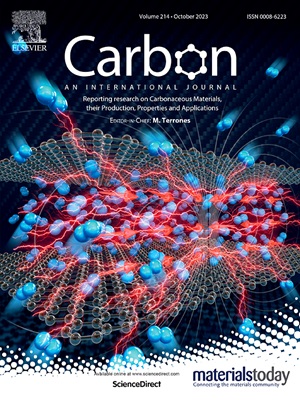Multifunctional high entropy metal/metal oxide hybrid nanostructures-embedded carbon nanofiber composites for electrochemical energy storage
IF 10.5
2区 材料科学
Q1 CHEMISTRY, PHYSICAL
引用次数: 0
Abstract
Carbon nanofibers (CNF) containing high-entropy metal/metal oxide hybrid (HEMMOs) nanostructures are fabricated by electrospinning to improve the overall electrochemical performance. The HEMMO nanostructures have an unique configuration that represents the formation of a single phase metallic alloy nanoparticles consisting of the Fe, Co, Ni, and Cu elements on the surface of manganese oxide-CNF composites structure. The porosity and crystallinity of HEMMOs in the HEMMO/CNF composites were carefully controlled by varying the concentration of metal acetic acid precursors and the oxidation stabilization time, and their electrochemical performances were compared. The optimized HEMMO/CNF hybrid materials deliver a specific capacitance of 215 Fg-1 at 1 mAcm−2 with 75 % specific capacitance retention in a symmetric two-electrode cell using a 6 M KOH electrolyte. It also shows a maximum energy density of 26.0 Whkg−1 at power densities of 400 Wkg-1 along with excellent cycling stability of 90 % retention at 1 mAcm−2 after 10,000 cycles. An asymmetric device exhibits a high energy density of 41 Whkg−1 at a power density of 400 Wkg-1, and a stable energy density of 23 Whkg−1 even at a high power density of 10,000 Wkg-1 when the operating voltage was increased to 1.4 V. The porous structure of HEMMO/CNF containing crystalline high entropy metal nanoparticles significantly enhances the stored charge capacity due to the synergistic effects of more redox-active sites and unique 3D diffusion channels into the electrolyte.
多功能高熵金属/金属氧化物杂化纳米结构——用于电化学储能的嵌入碳纳米纤维复合材料
采用静电纺丝法制备了含有高熵金属/金属氧化物杂化(HEMMOs)纳米结构的碳纳米纤维(CNF),以提高其整体电化学性能。HEMMO纳米结构具有独特的构型,代表了在氧化锰- cnf复合结构表面形成由Fe、Co、Ni和Cu元素组成的单相金属合金纳米颗粒。通过改变金属乙酸前驱体的浓度和氧化稳定时间来控制HEMMO/CNF复合材料中HEMMO的孔隙度和结晶度,并比较了它们的电化学性能。优化的HEMMO/CNF混合材料在1 mAcm−2下的比电容为215 gf -1,在使用6 M KOH电解质的对称双电极电池中,比电容保持率为75%。在功率密度为400 Wkg-1时,它的最大能量密度为26.0 Whkg -1,并且在1 mAcm - 2下循环10,000次后保持90%的优异循环稳定性。当功率密度为400 Wkg-1时,非对称器件的能量密度为41 Whkg -1;当工作电压增加到1.4 V时,即使功率密度为10,000 Wkg-1,器件的能量密度也稳定在23 Whkg -1。含有结晶型高熵金属纳米颗粒的HEMMO/CNF的多孔结构,由于更多的氧化还原活性位点和独特的3D扩散通道的协同作用,显著提高了存储电荷的容量。
本文章由计算机程序翻译,如有差异,请以英文原文为准。
求助全文
约1分钟内获得全文
求助全文
来源期刊

Carbon
工程技术-材料科学:综合
CiteScore
20.80
自引率
7.30%
发文量
0
审稿时长
23 days
期刊介绍:
The journal Carbon is an international multidisciplinary forum for communicating scientific advances in the field of carbon materials. It reports new findings related to the formation, structure, properties, behaviors, and technological applications of carbons. Carbons are a broad class of ordered or disordered solid phases composed primarily of elemental carbon, including but not limited to carbon black, carbon fibers and filaments, carbon nanotubes, diamond and diamond-like carbon, fullerenes, glassy carbon, graphite, graphene, graphene-oxide, porous carbons, pyrolytic carbon, and other sp2 and non-sp2 hybridized carbon systems. Carbon is the companion title to the open access journal Carbon Trends. Relevant application areas for carbon materials include biology and medicine, catalysis, electronic, optoelectronic, spintronic, high-frequency, and photonic devices, energy storage and conversion systems, environmental applications and water treatment, smart materials and systems, and structural and thermal applications.
 求助内容:
求助内容: 应助结果提醒方式:
应助结果提醒方式:


